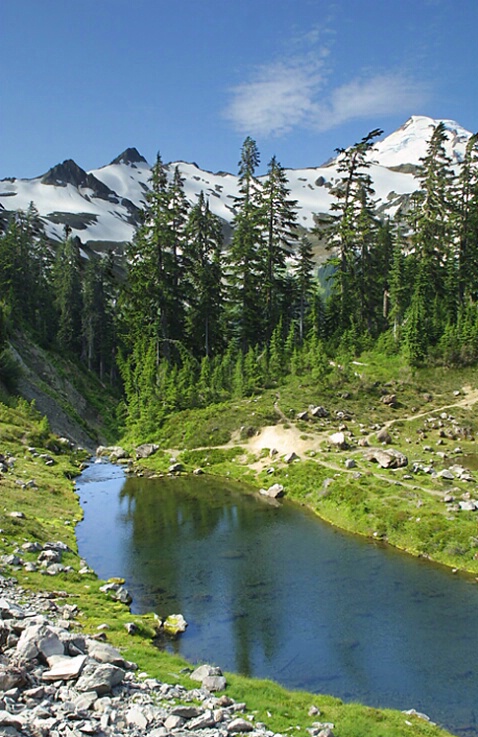Natural Neutral Density

Uploaded: October 07, 2003 18:20:44
Mt. Baker, WA. Creating a composite of two images allowed me to capture both extremes in contrast.
Jessica Hughes January 26, 2004
This looks like a beautiful place to photograph! #91387
Jim Miotke
 My Courses January 28, 2004
My Courses January 28, 2004
Thanks again for commenting. #350994
Jim Miotke
 My Courses February 11, 2004
My Courses February 11, 2004
Because the tones in this scene ranged in contrast too much - with the land and lake being relatively dark and the sky being very bright - there was no way (short of using a graduated neutral density filter) for me to accurately capture all the tones.
As I did not have a graduated ND filter with me, I exposed one photo for the sky and then took another photo, exposing for the land. Then, back in the comfort of my home, I combined the two images in Photoshop. #372264
RJ Baynum February 18, 2004
I think using photo shop to make an image, is basicly cheating and teaching people to do so in photo shop is also not very ethical. #384706Jessica Hughes February 20, 2004
Jim, I think you are doing a fine job! Photoshop is wonderful!
Jim Miotke
 My Courses February 21, 2004
My Courses February 21, 2004
I too love Photoshop and all the perfecting it allows us to do.
Thanks again! #389839
Kelly Moore March 05, 2004
I happened upon this picture and read the comments from RJ and felt I had to add my own thoughts. While I would agree, on one hand, I feel like some of what RJ said was correct, on the other hand, You mastered the picture the way your mind saw it. The reason Ansel Adams' pictures are so wonderful to look at isn't because that's what he captured on film, his pictures are so wonderful because he was able to master the darkroom. To achive the pictures he produced, he dodged and burned them to the limit and added filters in the exposure from negative to paper to get what his eye saw. To that extent, what was done to achive the range in this photo, is exactly the same. #410130Tobias B. Beharrell March 24, 2004
Jim - the beauty of nature cannot be minimized by the manner in which we "record" it! This is a lovely capture you have made. Having spent literally years studying such digital programs as Adobe Photoshop, I have no doubt that such digital skills are very comparable to any "editing" done - either in-camera or in the dark room! Any suggestion to the contrary would seem to indicate lack of personal experience with such things. If I were a painter, and the sky was "flat grey" on this day, would I be "cheating" to instead paint a lovely blue sky in? I think not.Danilo Piccioni April 16, 2004
Jim,Jim Collier June 08, 2004
With all due respect to the person who said it, the cry of "that's cheating" is bunk. The fact is, digital sensors capture FAR less dynamic range than film. If this had been on negative film, you wouldn't have had to do a thing. But since it's digital, we all need all the help we can get, because digital really sucks for dynamic range.Besides, nobody complains when analog photographers use a Contrast Mask--a processing method specifically intending (in most cases) to to narrow the dynamic range by pulling out dark and light details. You can do the exact same thing in Photoshop.
Now if you had edited in a giraffe or an extra mountain, then I too would be yelling, "that's cheating".
BTW, I've used the method you used often, but I've discovered a much easier way to get the same result. It's better in one way because you don't get the transition problems where one blends into the other. But it's not as good in another way, because you do get a little more noise (but not anywhere near as much as, say, doing Equalize on a dark photo). This is my own "patented invention":
• Open original.
• Perform an "Auto-Contrast".
• Copy background layer.
• Copy background layer again (for three total layers).
• Select top layer.
• Desaturate colors of this layer to B&W.
• Invert colors (for a negative image).
• Set layer type to "SOFT LIGHT".
• Set layer opacity to 75%, or whatever looks best (don't worry about too much color saturation yet).
• Flatten top layer into layer below.
• Set new top layer property to "Luminosity".
• Flatten into the bottom layer.
• There may be too much color saturation. Back it off a bit.
Here's how to do a traditional Contrast Mask, which gives very different results (sometimes better, usually worse, than the above method):
• Open original.
• Perform an "Auto-Contrast".
• Copy background layer.
• Copy background layer again (for three total layers).
• Select top layer.
• Desaturate colors of this layer to B&W.
• Invert colors (for a negative image).
• Set layer type to "Overlay".
• Open Gaussian Blur dialog, set to an amount that works well. Start at 90 (yes 90), and try higher & lower. Hit OK.
• Flatten top layer into layer below.
• Set new top layer property to "Luminosity".
• Flatten into the bottom layer.
• There may be too much color saturation. Back it off a bit.
To get even better results with both methods, when the instructions stay "Desaturate colors", do this instead: insert one layer of a flattened 50/50 mix of a regular desaturated image, and the Brightness channel from a LAB mode conversion. Using either one alone produces variously odd, noisy, or less than ideal results. A 50/50 mix is just about perfect. You might make a Photoshop Action to do this quickly.
Hope this helps!
Jim #583675
Sign up for an interactive online photography course to get critiques on your photos.
Discussions by Category: You can view photo discussions on various themes in the Community > Photo Discussions section of the site.
BetterPhoto Websites: If you see an orange website link directly under the photographer's name, it's totally okay. It's not spam. The reason: BetterPhoto is the one that offers these personal photography websites. We are supporting our clients with those links.
Unavailable EXIF: If there is no other information but 'Unavailable' in the EXIF (meaning no EXIF data exists with the photo), the 'Unavailable' blurb is not displayed. If there is any info, it shows. Many photos have the EXIF stripped out when people modify the image and resave it, before uploading.
The following truth is one of the core philosophies of BetterPhoto:
I hear, I forget.
I see, I remember.
I do, I understand.
You learn by doing. Take your next online photography class.
Copyright for this photo belongs solely to Jim Miotke.
Images may not be copied, downloaded, or used in any way without the expressed, written permission of the photographer.
Contact photographer via gallery
Log in to follow or message this photographer or report this photo.

I already have an account!

